According to superstition, apricots are bad luck in the Marines. According to fact, they’re good luck in your Southern California garden.
Marines may shun the apricot tree, but gardeners should welcome it. Some magnificent specimens grow to 30 feet and bear up to 300 pounds of fruit per season for 20 to 30 years.
The “Armenian Apple” also produces valuable fine-grained wood for musical instruments like recorders, flutes, and clarinets. And the uber-delicious apricot fruit is a rich source of vitamin A, potassium, and antioxidants.
All About the Apricot Tree
Native to China, apricot trees have traveled to places as far-flung as Southern California, where the mild winters and warm summers create ideal conditions for certain apricot varieties.
Trees typically grow to a mature height of 15 to 30 feet, depending on the variety and care they receive.
Dwarf varieties remain at approximately 8 to 10 feet. Their compact size ensures that even homeowners with limited space can enjoy the shade and bounty of an apricot tree.
California is the leading apricot-producing state in the United States as of 2024, accounting for about 94% of the harvest. Nevertheless, California’s apricot industry has declined over the past two decades, with bearing acreage decreasing by 62%.
That’s where you can make up the difference.
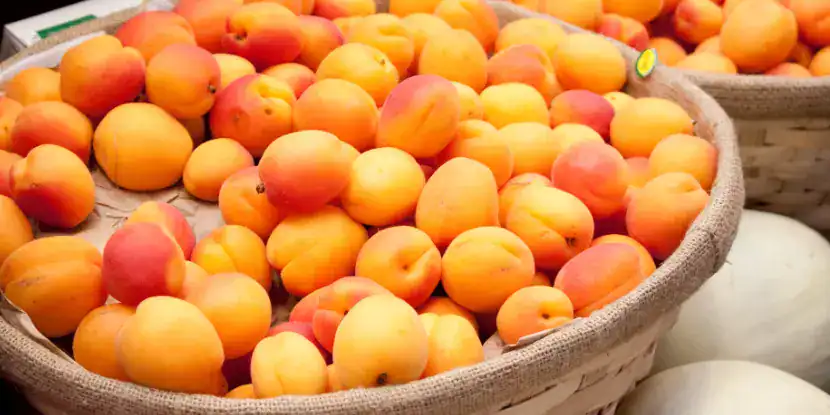
A bumper crop of fresh apricots.
Low-Chill Varieties for Southern California
Chill hours refer to the cumulative number of hours an apricot tree spends in temperatures between 32°F and 45°F during its dormant winter period.
These hours are crucial for the tree’s overall health and productivity, as they help to break dormancy and ensure healthy flowering and fruit development.
Low-chill apricot varieties thrive in climates with fewer chill hours. You can maximize your chances of a successful harvest by selecting the appropriate variety for your region’s chill hour range.
Gold Kist
- Chill Hours Required: ~300
- Known for early harvests and sweet, juicy fruit.
- Great for both fresh eating and homemade jams.
Katy
- Chill Hours Required: ~200-300
- Produces large, sweet fruit early in the season.
- Hardy and reliable, even in slightly warmer areas.
Royal (Blenheim)
- Chill Hours Required: ~300
- A heritage variety with exceptional flavor.
- Perfect for drying and preserves.
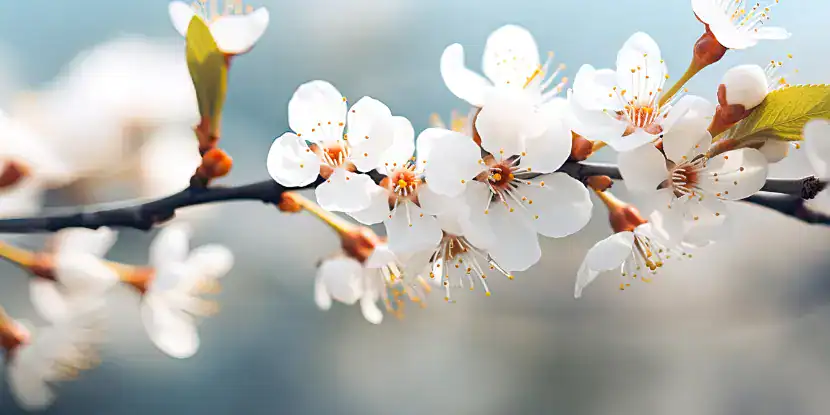
Apricot blossoms promise a plentiful harvest.
Optimal Growing Conditions
Light
- Provide your apricot tree with at least 6–8 hours of direct sunlight daily.
- Plant in an open spot with good exposure. Avoid shaded areas.
Temperature
- Apricots love moderately cold winters and warm summers.
- LA’s temperature range aligns well with the needs of low-chill varieties.
- Protect young plants from frost by covering them during cold snaps.
Soil
- Soil must be well-draining.
- Sandy or loamy soil with a neutral pH range (6.5–7.5) works best.
- Avoid clay-heavy soils that retain moisture and may lead to root rot.
Propagating Apricot Trees
Apricots can be propagated through seeds, cuttings, or grafting. Most gardeners prefer buying young, grafted saplings from local nurseries for faster fruit production and reliable varieties.
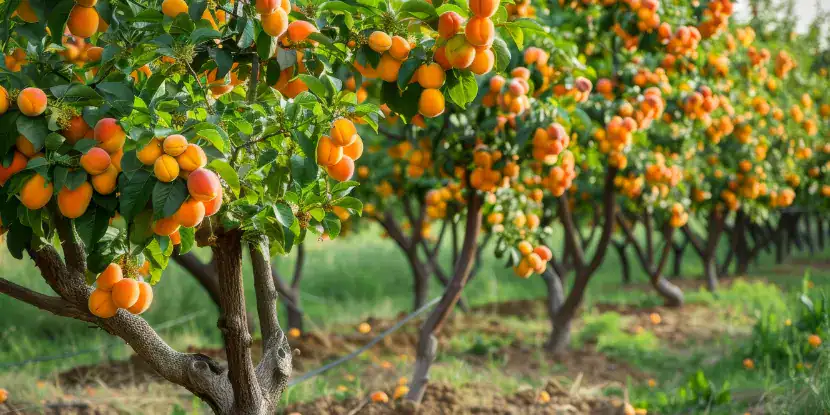
Apricot trees laden with fruit.
Steps for Planting
Plan your planting in late winter or early spring, while the tree is still dormant.
- Select a sunny location with well-draining soil.
- Maintain at least 15 feet between the apricot tree and other large plants or structures.
- Dig a planting hole twice as wide as the root ball and slightly deeper than it.
- Place the sapling carefully in the hole, ensuring the graft line stays above the soil.
- Backfill with soil, gently firming it down as you go.
- Water immediately after planting to eliminate air pockets and help the roots establish.
- Spread 2–3 inches of mulch around the base to retain moisture and suppress weeds.
Apricot Tree Care
Watering
- Water regularly, especially during the growing and fruiting season. Allow the soil to dry slightly between waterings.
- Apply deep and infrequent watering to encourage strong root growth.
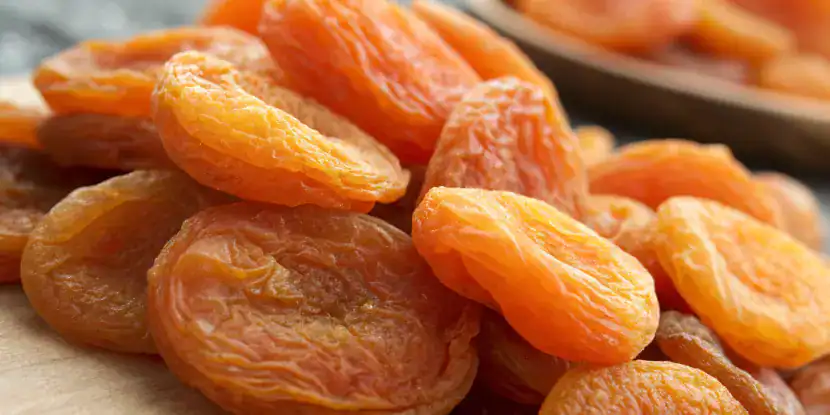
Dried apricots are as tasty as the fresh fruit.
Fertilizing
- Use a balanced fertilizer (10-10-10) in early spring before new growth begins.
- Avoid over-fertilizing. Excessive nitrogen can result in more leaves and fewer fruits.
Pests & Diseases
- Common pests include aphids, scale, and peach twig borers. Use insecticidal soap or horticultural oils to manage infestations.
- Watch for bacterial canker or gummosis and prune affected areas promptly.
Pruning
- Prune annually during winter (dormant season). Remove dead or diseased branches and improve airflow by thinning overcrowded areas.
- Aim for an open-center shape in the tree’s canopy for maximum light exposure.
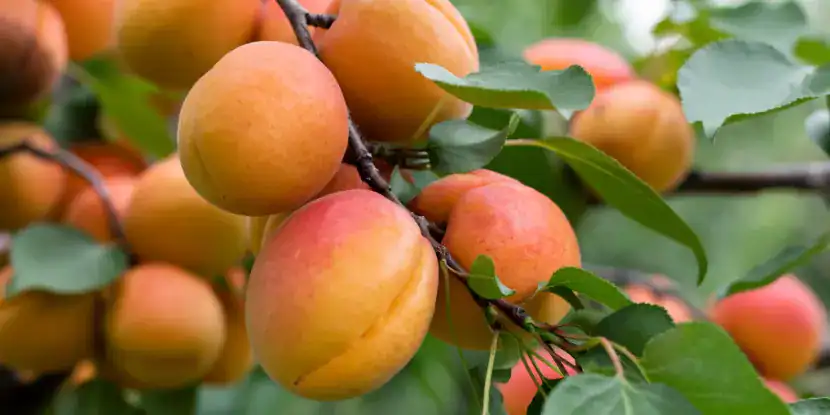
Ripe apricots ready for harvest.
Harvesting & Storing Apricots
- Most apricots ripen between late spring and mid-summer, depending on the variety.
- Look for firm yet slightly soft fruit with a golden-orange hue. Fruit should come off the branch with a gentle twist.
- Refrigerate apricots to keep them fresh for up to a week.
- For longer storage, consider freezing slices or making preserves.
FAQs: Growing Apricots
Q: Can I grow an apricot tree in a container?
Dwarf varieties do well in large pots with proper drainage.
Q: Do I need two apricot trees for pollination?
Many low-chill varieties are self-pollinating, but a second tree can improve fruit production.
Q: How long does it take for an apricot tree to bear fruit?
Typically, 3–4 years after planting, though some grafted trees may fruit sooner.
Q: How often should I water my tree?
Once or twice a week during dry spells; adjust based on rainfall and soil moisture.
Q: What’s the best time of year to plant?
Late winter or early spring, while the tree is still dormant.
Q: Why aren’t my apricots ripening?
Insufficient sunlight or premature harvesting could be the cause.
Q: What fertilizer is best for apricot trees?
Use a balanced fertilizer or one formulated for fruit trees.
Q: Can I grow apricots from seed?
Yes, but they may not produce fruit identical to the parent tree.

